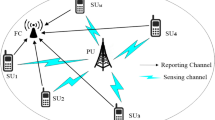Abstract
In cooperative spectrum sensing, secondary users can cooperate based on their local sensing observations so as to detect primary signals in a more reliable manner. However, because of the low strength of received primary signals, observations from some secondary users may contribute little to global decisions at the fusion center. To reduce energy consumption and sensing overhead, cooperation is recommended only with a subset of nodes receiving high-strength primary signals. This paper proposes a selection probability based cooperative spectrum sensing scheme that exploits historical observations to exclude nodes receiving low-strength primary signals. The selection probability is maintained based on local sensing information and global decisions. Simulation results demonstrate that the proposed scheme can exploit location advantages and shows almost the same detection performance as cooperative spectrum sensing with accurate node selection.






Similar content being viewed by others
References
Mitola, J., & Maguire, G. Q. (1999). Cognitive radio: Making software radios more personal. IEEE Personal Communications, 6(4), 13–18.
Haykin, S. (2005). Cognitive radio: Brain-impowered wireless communications. IEEE Journal on Selected Areas in Communications, 23(2), 201–220.
Urkowitz, H. (1967). Energy detection of unknown deterministic signals. Proceedings of IEEE, 55(4), 523–531.
Digham, F. F., Alouini, M.-S., & Simon, M. K. (2007). On the energy detection of unknown signals over fading channels. IEEE Transation on Communications, 55(1), 21–24.
Cabric, D., Mishra, S. M., & Brodersen R. W. (2004). Implementation issues in spectrum sensing. In Proceedings of Asilomar conference on signal, systems and computers, Monterey, USA (pp. 772–776).
Sahai, A., Cabric, D., Hoven, N., Tandra, R., Mishra, S., & Brodersen, R. (2005). Spectrum sensing: Fundamental limits and practical challenges. In Proceedings of the IEEE international symposium on dynamic spectrum access networks, Baltimore, Maryland.
Liang, Y.-C., Zeng, Y. H., Peh, E., & Hoang, A. T. (2008). Sensing throughput tradeoff for cognitive radio networks. IEEE Transactions on Wireless Communications, 7(4), 1326–1337.
Ma, J., Zhao, G., & Li, Y. (2008). Soft combination and detection for cooperative spectrum sensing in cognitive radio networks. IEEE Transactions on Wireless Communications, 7(11), 4502–4507.
Ganesan, G., & Li, Y. (2007). Cooperative spectrum sensing in cognitive radiopart: Multiuser networks. IEEE Transactions on Wireless Communications, 6(6), 2214–2222.
Letaief, K. B., & Zhang, W. (2009). Cooperative communications for cognitive radio. Proceedings of the IEEE, 97(5), 878–893.
Quan, Z., Shuguang, C., & Sayed, A. H. (2008). Optimal linear cooperation for spectrum sensing in cognitive radio networks. IEEE Journal of Selected Topics in Signal Processing, 2(1), 28–40.
Cui, T., & Kwak, K. (2013). Conservative cooperative spectrum sensing without CRC in CR network. IEICE Communications Express, 2(4), 161–166.
Cui, T., & Kwak, K. (2013). Cooperative spectrum sensing with adaptive node selection for cognitive radio networks. In Proceedings of the fifth international conference on ubiquitous and future networks (ICUFN), Da Nang, Vietnam (pp. 506–510).
Selen, Y., Tullberg, H., & Kronander, J. (2008). Selection for cooperative spectrum sensing. In Proceedings IEEE DySPAN, Chicago, USA (pp. 1–11).
Khan, Z., Lehtomaki, J., Umebayashi, K., & Vartiainen, J. (2010). On the selection of the best detection performance sensors for cognitive radio networks. IEEE Signal Processing Letters, 17(4), 359–362.
Yuan, W., Leung, H., Chen, S., & Cheng, W. (2011). A distributed sensor selection mechanism for cooperative spectrum sensing. IEEE Transactions on Signal Processing, 59(12), 6033–6044.
Acknowledgments
This research was supported by the MSIP (Ministry of Science, ICT and Future Planning), Korea, under the ITRC (Information Technology Research Center) support program (NIPA-2014-H0301-14-1042) supervised by the NIPA (National IT Industry Promotion Agency).
Author information
Authors and Affiliations
Corresponding author
Rights and permissions
About this article
Cite this article
Cui, T., Kwak, K.S. Cooperative Spectrum Sensing with Adaptive Node Selection for Cognitive Radio Networks. Wireless Pers Commun 78, 1879–1890 (2014). https://doi.org/10.1007/s11277-014-2050-2
Published:
Issue Date:
DOI: https://doi.org/10.1007/s11277-014-2050-2




